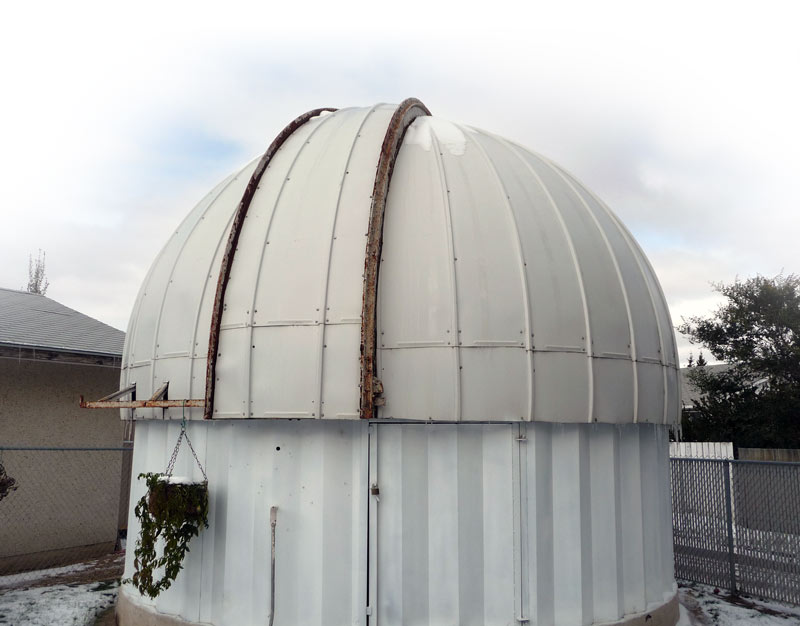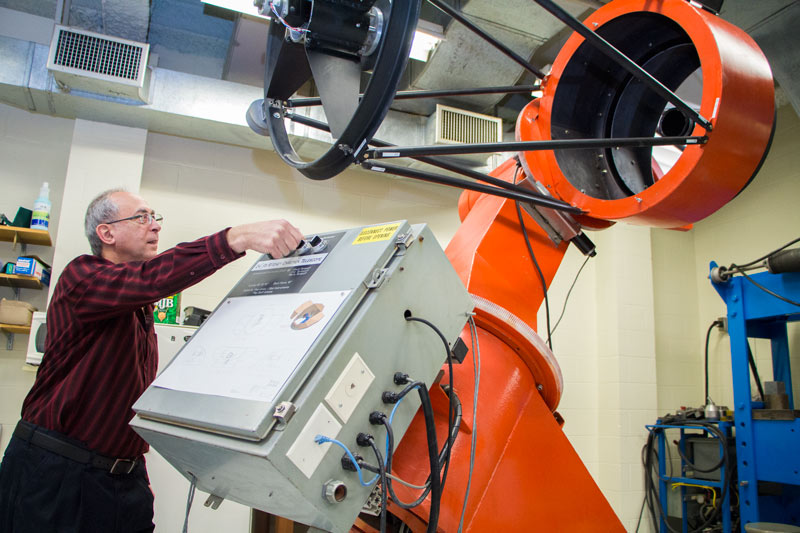ON A SPRING DAY in 1978, Karen Larson came home from work to find an 18-foot observatory dome in her backyard.
Standing next to it was her husband, Harry Tarasoff (BA’68, LLB’71). “He was so pleased with himself,” Larson remembers.
Tarasoff, who passed away in 2008, had always been “full of dreams,” says Larson. “His brain was always working, looking for the next challenge, figuring things out.”
His latest dream—to construct a full-scale rotating dome observatory—might have been challenge enough for most amateur astronomers. But for Tarasoff, such a magnificent stargazing platform called for a telescope to match: something greater than the portable store-bought instrument he had been using until now.
He told his wife, “I’m going to build a telescope bigger than this.”
Harry the inventor
Tarasoff was born in 1947 into a Doukhobor family near Langham, Sask. From early on, he showed signs of being gifted. By Grade 4 he was handling the family’s income taxes and advising on the operation of the farm, says Larson.
Along the way he was always tinkering, building and deconstructing. With his brother, he built his own motorcycle, and he once disassembled, piece by piece, his grandfather’s old gramophone (“much to the consternation of their mother,” says Larson).
Tarasoff earned degrees in physics and law from the U of S, but found employment as a labourer at a Saskatoon asphalt company. He soon worked his way up from sweeping floors to operating, maintaining and even designing the heavy-duty equipment needed to run the business.
“He was hands-down the hardest-working person I’ve ever met in my life,” says his son Gavril Tarasoff (BSc’04).
In the late 1980s, Harry Tarasoff, his brother and a friend established their own asphalt company in Saskatoon, HJR Asphalt. The business thrived, thanks in part to the tailor-made equipment Tarasoff created for their work.
“His job was to build roads, but really he was an inventor,” says his son.

A lucky discovery
The structure that arrived at Tarasoff and Larson’s Saskatoon home in 1978 was the original papier-mâché dome from the U of S observatory, which Tarasoff chanced upon at a storage yard following an upgrade to the campus observatory. He purchased it on the spot.
The dome would crown a steel and concrete building Tarasoff planned to construct in the backyard. Larson was reluctant to give up such a large portion of her newly built yard—“That was going to be my garden spot!” she laments—but her husband’s joy at his rare find changed her mind.
The couple reached a compromise. Tarasoff would have his observatory; it would house the towering telescope of his dreams and offer an unmatched view of the cosmos, but it would also store the lawnmower.
The biggest telescope
Work and family came first, so more than two decades passed before Tarasoff realized his ambition of building a telescope as impressive as his observatory. He ordered custom optics in 1993, but it wasn’t until 2003 that he finished purchasing or fabricating all the pieces he needed.
With help from his sons Gavril and Elia (BSc’07)—both graduates of the Department of Computer Science—Tarasoff assembled the telescope in his company’s shop, programmed its movement and proudly installed it in his home observatory.
The completed telescope features a Ritchey-Chrétien layout—the ultra-sharp optical design standard on high-performance professional telescopes—on a sturdy frame welded in Tarasoff’s signature overbuilt style.
At over nine feet tall with a primary mirror 24 inches in diameter, it is likely the largest optical telescope in Saskatchewan.
But almost as soon as he had finished, Tarasoff set his sights higher. He began work on building another instrument that would rival the largest amateur telescope in the world.

Tarasoff tracked down and purchased an enormous 69-inch blank, a specialized glass block from which a telescope mirror is shaped. But when he looked into hiring a company to grind it into a mirror, he hit an obstacle.
“They said that it would take them 10 years and 10, 15 million dollars,” recalls Gavril Tarasoff.
Undeterred, Harry Tarasoff vowed to do the monumental task himself. He convinced a Montreal optics manufacturer to let him spend time at their laboratory learning how precision mirrors are ground. He purchased an enormous rotating table, constructed a crude but effective grinding apparatus and transformed a steel shipping container attached to an old cottage into a makeshift optics lab. A laser bouncing off the glass measured his progress and a remote video feed let him make adjustments from home.
Tarasoff passed away before he could finish his mirror, but the progress he made still inspires awe within the local astronomy community.
“That somebody would even dream of undertaking such a big project like the 69-inch telescope that he had in mind, to me it’s mind-boggling,” says Yannis Pahatouroglou, senior departmental assistant in the Department of Physics and Engineering Physics.
A new home on campus
One of Tarasoff’s greatest creations lives on in the College of Arts & Science. Before he died, he reconnected with the physics department to discuss finding a home at the U of S for his finished telescope. In 2014, his wife and family donated it to the college.
Nearly twice the diameter of any other telescope on campus, the Tarasoff 24-inch telescope is an exciting addition to the department’s teaching and research tools, says astronomy lecturer Stan Shadick.
“Basically, it improves the quality of our data by about a factor of four.”

The department is now refurbishing the telescope using funds also donated by Larson and her family, and plans are underway to have it installed within a newly built enclosure on the roof of the Physics Building.
Shadick says he and his students will make extensive use of the Tarasoff telescope in astronomy courses and in researching hard-to-study objects such as exoplanets: planets orbiting other stars. Members of the public might also have the chance to look through the telescope as part of the department’s outreach.
Larson is happy to see others benefit from a unique product of her husband’s ingenuity and drive: a lasting memory of a man she remembers being “always on an exciting adventure” to understand the world around him and conquer the next great challenge.
Exoplanets: seeing the invisibleSome of the most valuable research that can be done with small to mid-sized optical telescopes like those in the College of Arts & Science is the study of exoplanets: planets in other star systems.Exoplanets cannot be observed directly, but can be detected by measuring the amount that a star’s light dims as the planet passes in front of—or transits—the star.Stan Shadick and his astronomy students in the Department of Physics and Engineering Physics are part of an international collaboration that monitors these transits to deepen our knowledge of known exoplanets. The
|